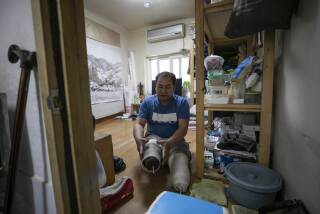In Overcrowded Hong Kong, Scores Have Only a Cramped ‘Cage’ to Call Their Own
- Share via
HONG KONG — Lui Kow spends most of his days hunched over on his bed playing solitaire. He can’t stand up in his home. There is no room.
The 73-year-old Lui lives in a “cage.” He has lived there for 25 years. His 52-year-old mentally retarded son lives in another cage in the same apartment.
“We live here because we can’t afford anything else,” said Lui, who pays $18 a month for his rented accommodation.
Lui and his son are two of some 700 “caged men”--most of them elderly--who live in 6-by-3-foot bunks surrounded by wire mesh in 18 decaying apartments on Hong Kong’s crowded Kowloon Peninsula.
Each of the three-deep bunks serve as one man’s entire living space. They cram their tiny areas with pictures, clothes and dishes--everything they own. They surround the bunks with wire to protect themselves and their possessions.
Lui has lived in several cages in the apartment since he first moved there in 1963. “I’ve got the best cage now,” he said, proudly pointing to a tiny broken window at one end that looks out over bustling Nam Cheong Street.
Ninety-one other men live in cages in the same apartment as Lui. They share three grimy stand-up toilets, one cold faucet that serves as a shower and one small refrigerator. They cook their meals on an open stove on the building’s roof. They eat in their cages.
In the evening, some of the men crowd around the apartment’s one television in 68-year-old Chan Kakee’s cage.
Chan, who has lived in his cage for 32 years, rents the apartment from an absentee landlord and sublets the cages to the other men.
“It’s useless to complain to anyone,” said Chan about the dampness, broken windows and scurrying mice in the apartment.
“Many church organizations and welfare groups have come here. They want to help, but nothing ever happens,” he added.
“These men have very little contact with the outside world,” said the Nam Cheong Federation of Social Concern--a local concern group--in a recent report. “They have no hopes and don’t trust other people. They’re just waiting for death,” said the report, based on two years of research.
With a population of 5.65 million, Hong Kong is one of the most densely populated places on Earth. Census figures show that in one part of Kowloon, about 200,000 people share a space only slightly larger than half a square mile, a density rate of 360,000 residents per square mile.
In comparison, Manhattan, the most densely populated area of the United States, has a density of 65,000 people per square mile.
Choi Ka Ming, 64, has lived in the same cage since he came to the British colony from mainland China 30 years ago. He locks his “home” even when going to the toilet.
“I’m afraid people will steal my things,” said Choi, an emaciated man racked by lung disease.
But Choi doesn’t want to move even if offered better housing. “I have all my friends here,” he said. “The man underneath me has lived here for 30 years too.”
Bonnie Yip, of Hong Kong’s Social Welfare Department, said many of the caged men moved to the colony from mainland China 30 or 40 years ago.
“They grouped together then, rented one place so they could look after each other,” she said. “Some died, newcomers came and eventually they were living only in bed-spaces.”
Possibilities for moving are remote, even if the men wanted to, as some do. Almost half of Hong Kong’s population--2.5 million people--live in public housing. About 145,000 families are on the waiting list for government accommodation. Waiting time is between six and seven years.
“It’s not the work of the housing department to go look for these people and house them,” said Frank Chuan of Hong Kong’s housing department.
“They put the cages up themselves to protect their property,” he said. “It’s not built by the landlords.”
“It’s not the housing department’s problem,” he said. “I don’t know whose it is.”
More to Read
Sign up for Essential California
The most important California stories and recommendations in your inbox every morning.
You may occasionally receive promotional content from the Los Angeles Times.










